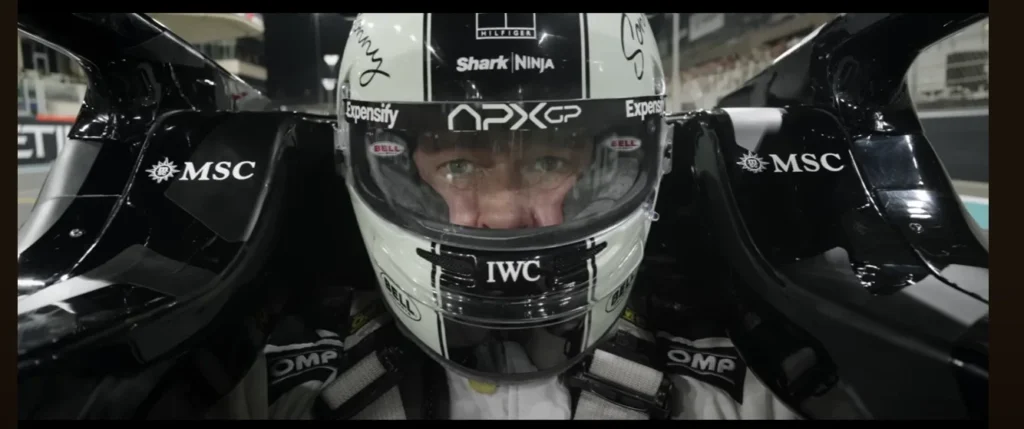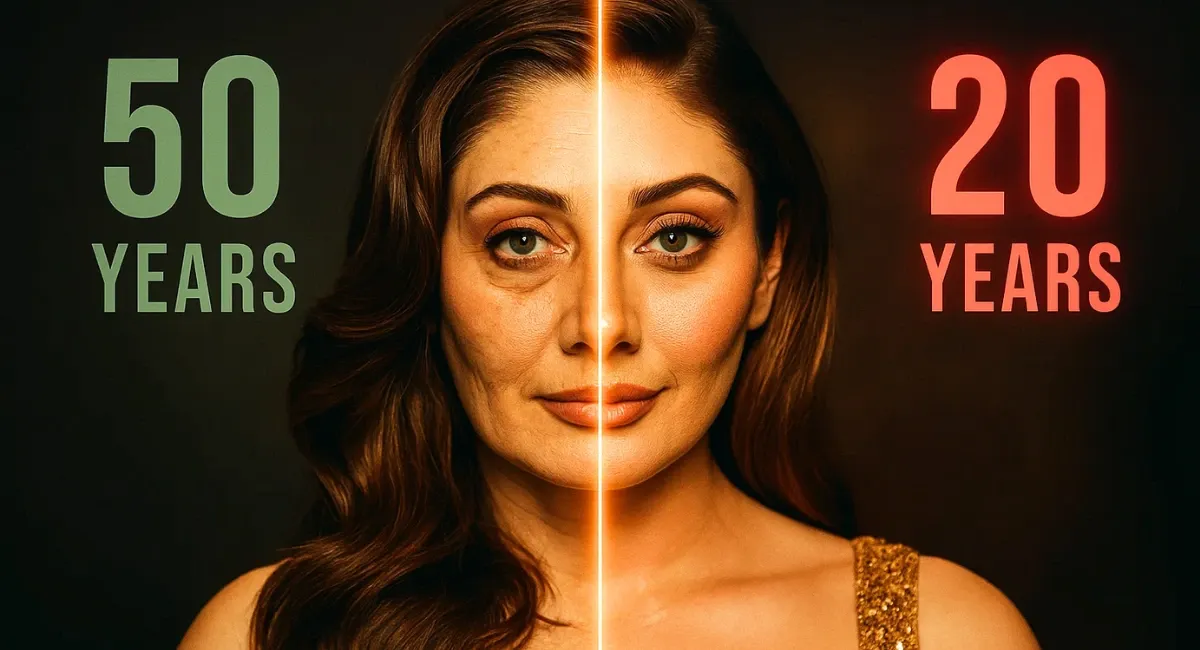This F1 movie review 2025 examines Brad Pitt’s collaboration with director Joseph Kosinski (Top Gun: Maverick) for an immersive plunge into Formula 1 racing. With official FIA backing and Lewis Hamilton’s producer credit lending unique authenticity, does the film deliver beyond the adrenaline rush?
The answer: mostly yes, though your mileage may vary depending on what you’re seeking under the hood.
Plot & Narrative Arc: From Van-Dweller to Victory Lane
Sonny Hayes starts the film as Formula 1’s greatest “what if” story. After a career-ending crash at Spain’s Jerez circuit in the 1990s, he’s spent three decades drifting between small-time races and living out of a van.
When old teammate Ruben Cervantes (Javier Bardem) offers him a lifeline with the struggling APXGP team, Hayes faces his biggest gamble yet. You watch a man who’s made peace with obscurity suddenly thrust back into the spotlight.
Supporting Storylines That Racing Fans Will Love
Rookie Joshua Pearce (Damson Idris) provides the perfect foil, talented but impatient, representing everything Hayes once was. Their mentor-student relationship builds naturally through shared cockpit time and heated exchanges in team meetings.
Kerry Condon shines as Kate McKenna, APXGP’s technical director and the first woman to hold such a position. Her character adds depth beyond the typical romantic subplot, showing genuine expertise and leadership.
Emotional Stakes That Sometimes Stall
The film’s strongest moments come during race sequences where personal stakes collide with split-second decisions. Unfortunately, the emotional beats between races occasionally feel like mandatory pit stops rather than natural story progression.
Character & Performance Analysis
Pitt delivers his most physically demanding performance in years. You see Hayes’s zen-like calm mask deeper trauma from his crash, creating a character who’s learned to live with risk rather than fear it.
His preparation shows, Pitt actually trained on Formula 2 cars for months before filming. The authenticity translates to screen confidence that sells every cockpit moment.
Damson Idris & Javier Bardem: The Next Generation
Idris captures Pearce’s hunger perfectly, making his rookie mistakes feel genuine rather than scripted. His chemistry with Pitt creates believable tension between old-school instinct and modern precision.
Bardem brings gravitas to Ruben, a team owner fighting for survival. His persuasive arc feels earned rather than convenient, anchoring the film’s emotional center.
Real F1 Cameos Add Authentic Racing Atmosphere
Lewis Hamilton, Fernando Alonso, and team principals like Toto Wolff appear seamlessly integrated into race weekend footage. Their presence elevates authenticity without feeling forced or gimmicky.
Technical & Aesthetic Craft: Racing Movie Excellence
Claudio Miranda’s revolutionary camera work deserves special recognition. Using seven custom Sony 6K cameras mounted inside cockpits, the film achieves unprecedented intimacy with speed.
The helmet-cam perspectives and wide-angle G-force shots make you feel every turn, brake, and acceleration. Race sequences rival Top Gun: Maverick for visceral impact.
Hans Zimmer’s Pulse-Pounding Musical Racing Symphony
Zimmer’s score blends orchestral grandeur with electronic elements that mirror engine sounds. His second Formula 1 film (after Rush) shows a deeper understanding of racing’s emotional rhythms.
The music swells during overtaking maneuvers and quiets during strategic pit stops, creating a perfect audio companion to Miranda’s visuals.
Practical Effects vs. Digital Enhancement
Real modified F2 cars provide the film’s backbone, with digital effects enhancing rather than replacing practical racing. When Pitt and Idris are driving, they’re actually moving at race speeds on actual circuits.
This commitment to practical filmmaking gives F1 a tactile quality missing from many modern action films.
Authenticity & F1 Collaboration Brings Real Racing to Life
FIA & Mercedes Partnership Creates Credible Racing World
Official Formula 1 sanction allowed filming during actual Grand Prix weekends at Silverstone, Monza, and other legendary circuits. The paddock atmosphere, team operations, and race-day tension feel completely authentic.
Mercedes-AMG provided technical expertise for the modified race cars, ensuring APXGP’s equipment looks and performs believably within F1’s demanding standards.
Real vs. Fictional Races: Does It Capture F1’s True Danger?
The film captures Formula 1’s strategic complexity and split-second decision-making exceptionally well. Pit stop sequences, tire strategy discussions, and radio communications all ring true to actual racing.
However, the life-or-death stakes that define real F1 feel somewhat sanitized for mainstream audiences.
Themes & Subtext: More Than Just Speed
Redemption vs. The Cost of Fame
Hayes’s journey explores whether second chances can truly erase past failures. The film examines how trauma shapes decision-making under extreme pressure. You see racing as both salvation and potential destruction, a double-edged relationship with speed that defines many real drivers.
Mentorship in a Cutthroat Sport
The veteran-rookie relationship transcends typical sports movie clichés. Hayes doesn’t just teach driving techniques; he shares survival wisdom earned through decades of crashes, wins, and losses.
Technology vs. Humanity in Modern Racing
F1 subtly explores how modern racing balances human instinct with data-driven precision. Hayes represents the old-school feel while Pearce embodies the new analytical approaches.
Pacing & Structure: High-Speed Thrills with Mid-Race Lulls
When cars hit the track, F1 becomes cinematic gold. Race sequences build tension through strategic moves, mechanical failures, and split-second overtaking opportunities. The final race delivers genuine edge-of-your-seat thrills that justify the film’s 156-minute runtime.
Between races, the screenplay occasionally gets bogged down in technical jargon and relationship development. Some pit-lane conversations feel more like information dumps than natural character moments. The film works best when it trusts racing action to carry emotional weight.

Audience Reception & Critical Consensus
Critics have awarded F1 an 84% rating on Rotten Tomatoes, with particular praise for technical achievements and Pitt’s performance. The consensus: “Driven by Brad Pitt’s laidback magnetism and sporting a souped-up engine courtesy of Joseph Kosinski’s kinetic direction.”
Audience reactions on social media celebrate the authentic racing atmosphere while noting the predictable story structure.
Easter Eggs & Behind-the-Scenes Racing Details
Hidden F1 History References
Sharp-eyed fans will spot references to legendary drivers and historic moments throughout background details. APXGP’s garage setup mirrors real team operations down to tire warming procedures.
The film includes subtle nods to racing safety improvements and technological advances that have shaped modern Formula 1.
Making-Of Insights: Actors Become Real Drivers
Pitt and Idris completed intensive driver training at Circuit Paul Ricard before filming began. Their preparation shows in every cockpit scene, creating believable driver performances. On-track filming required unprecedented coordination between film crews, race organizers, and team personnel during actual Grand Prix weekends.
Final Verdict: A Spectacle That Sometimes Coasts on Star Power
F1 delivers exceptional racing sequences and technical craftsmanship that make it a must-see theatrical experience. Brad Pitt’s committed performance and Kosinski’s directorial expertise create genuine excitement during track time.












